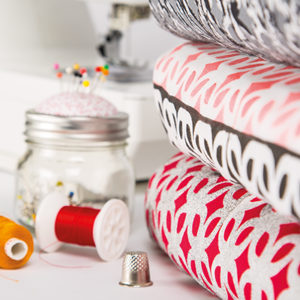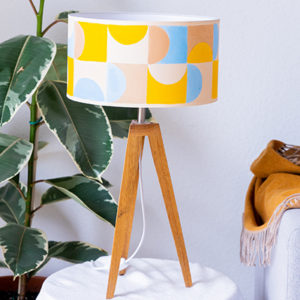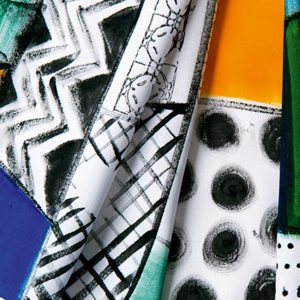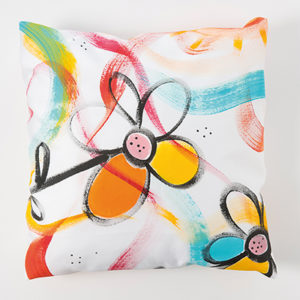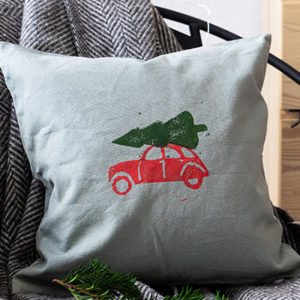Airbrushing with Marabu Textil
Using Marabu colours the airbrush technique offers a variety of great design possibilities on various substrates: from paper, wood & craft materials to glass & porcelain to textiles & silk.
Beautiful patterns or sharp outlines can be realised using this technique; photographically accurate pictures can be enhanced with special effects such as metallic gloss or mirror reflexes. The colour is mixed with the airflow in the spray pistol and is applied in extremely thin layers by constantly moving your hand. By varying the aperture of the nozzle, the distance to the painting substrate or by the use of stencils, there is no limit to your artistic scope.
General Advice:
Please follow the instructions for airbrush technique depending on paint type.
Further advice:
- Stir well before use or, if necessary, strain the colours.
- Choose the appropriate thinner for colour and substrate.
- The colour should be sufficiently liquid that it can pass through a teastrainer.
- The substrate should be dust and grease-free.
- Use self-adhesive templates.
- Ensure that the workplace is well ventilated and that spray mist is avoided.
- When changing colours, use the appropriate cleaning agent for the spray pistol - in the case of water-based Marabu-colours the appropriate cleaning agent is simply water.
- After use carefully clean all equipment with the appropriate cleaning materials.
- Always carry out pre-trials.
Separate instructions for airbrush technique depending on paint type:
Airbrushing with Marabu Textil
Nozzle size: from 0.3 mm
Pressure: from 2 bar
Thinning: 4 parts colour to 1 part water
Cleaning: with water
The specifications shown for nozzle sizes, dilution and pressures are guidelines only and should be adjusted accordingly.Sun Technique
The 'sun technique' using Marabu Textil or Marabu Silk is an excellent new way of decorating fabrics!
Firstly dilute Marabu Textil using water and apply it in large areas onto a thin fabric; use Marabu Silk undiluted. Put an opaque motif onto the paint when it is still wet (you could use motifs such as hearts, triangles, stars etc cut out from cardboard, rubber sponge or natural materials like leaves) and weigh down. Now expose the covered fabric to sunlight or to a powerful lamp (the quickest way to dry the fabric is using a powerful hairdryer). Depending on the intensity of the light, the covered areas will dry a lighter colour than the rest - your masterpiece is finished! When the fabric is totally dry, as well as below the motifs, it can be fixed according to instructions.
Please note that the wash-quality of the colours can be affected when you use extreme levels of dilution.
Using Marabu colours the airbrush technique offers a variety of great design possibilities on various substrates: from paper, wood & craft materials to glass & porcelain to textiles & silk.
Beautiful patterns or sharp outlines can be realised using this technique; photographically accurate pictures can be enhanced with special effects such as metallic gloss or mirror reflexes. The colour is mixed with the airflow in the spray pistol and is applied in extremely thin layers by constantly moving your hand. By varying the aperture of the nozzle, the distance to the painting substrate or by the use of stencils, there is no limit to your artistic scope.
General Advice:
Please follow the instructions for airbrush technique depending on paint type.
Further advice:
- Stir well before use or, if necessary, strain the colours.
- Choose the appropriate thinner for colour and substrate.
- The colour should be sufficiently liquid that it can pass through a teastrainer.
- The substrate should be dust and grease-free.
- Use self-adhesive templates.
- Ensure that the workplace is well ventilated and that spray mist is avoided.
- When changing colours, use the appropriate cleaning agent for the spray pistol - in the case of water-based Marabu-colours the appropriate cleaning agent is simply water.
- After use carefully clean all equipment with the appropriate cleaning materials.
- Always carry out pre-trials.
Separate instructions for airbrush technique depending on paint type:
Airbrushing with Marabu Textil
Nozzle size: from 0.3 mm
Pressure: from 2 bar
Thinning: 4 parts colour to 1 part water
Cleaning: with water
The specifications shown for nozzle sizes, dilution and pressures are guidelines only and should be adjusted accordingly.Sun Technique
The 'sun technique' using Marabu Textil or Marabu Silk is an excellent new way of decorating fabrics!
Firstly dilute Marabu Textil using water and apply it in large areas onto a thin fabric; use Marabu Silk undiluted. Put an opaque motif onto the paint when it is still wet (you could use motifs such as hearts, triangles, stars etc cut out from cardboard, rubber sponge or natural materials like leaves) and weigh down. Now expose the covered fabric to sunlight or to a powerful lamp (the quickest way to dry the fabric is using a powerful hairdryer). Depending on the intensity of the light, the covered areas will dry a lighter colour than the rest - your masterpiece is finished! When the fabric is totally dry, as well as below the motifs, it can be fixed according to instructions.
Please note that the wash-quality of the colours can be affected when you use extreme levels of dilution.
Removing finishes/pre-washing textiles
Before painting, new textiles have to be washed at least once without fabric conditioners. Fabric finishes and conditioners prevent the fibre from absorbing the paint. Colour fastness after fixing cannot be guaranteed in this case.Printing fabric by the bale
Pattern rollers are ideal for printing fabric by the bale with Marabu Textil.Double-layer textiles
When painting double-layer textiles (T-shirts or pillow cases), always place a piece of cardboard between the fabric layers to prevent the paint from seeping through. This also makes painting on fabric easier, particularly for children.Dispensing from the bottles
The special tops of the 250 ml and 500 ml textile bottles allow best possible dispensing of the paint.Fixing textile dyes
Exact and thorough fixing of the dye is absolutely required for obtaining permanent textile designs.Fixing combinations (Liner/textile colours)
Combinations of textile paints from a jar and from a Liner on textiles are best fixed in the oven for 8 minutes at 150 °C.Suitable textiles
Marabu textile paints can be used to paint on all textiles (free from finishes and detergents) made of cotton, linen, jute, silk, and mixed fabrics up to max. 20 % man-made fibres. Do not use on knitware as this cannot be fixed to be washable.Painting on silk
Dilute Marabu Textil with a little water for this. Painting will produce fixed outlines. Fix at cotton setting for 3 minutes from the reverse or for 8 minutes at 150 °C in the oven.Drying before fixing
Painted textiles should only be fixed once the paint has fully dried. Leave to dry over night if possible.Versatile printing stamps
Simple objects such as natural sponges, corks, wooden blocks or leaves are suitable for printing with Marabu Textil (use a small amount of paint). You can also make your own stamps from foam rubber.Washing painted textiles
Always wash painted textiles inside out and use a mild detergent. Never place a hot iron directly on the painted area. Iron either from the reverse or through a cloth.Painting T-shirts
When painting T-shirts, simply slide a piece of cardboard underneath the fabric to prevent the paint from seeping through the layers.
Before painting, new textiles have to be washed at least once without fabric conditioners. Fabric finishes and conditioners prevent the fibre from absorbing the paint. Colour fastness after fixing cannot be guaranteed in this case.Printing fabric by the bale
Pattern rollers are ideal for printing fabric by the bale with Marabu Textil.Double-layer textiles
When painting double-layer textiles (T-shirts or pillow cases), always place a piece of cardboard between the fabric layers to prevent the paint from seeping through. This also makes painting on fabric easier, particularly for children.Dispensing from the bottles
The special tops of the 250 ml and 500 ml textile bottles allow best possible dispensing of the paint.Fixing textile dyes
Exact and thorough fixing of the dye is absolutely required for obtaining permanent textile designs.Fixing combinations (Liner/textile colours)
Combinations of textile paints from a jar and from a Liner on textiles are best fixed in the oven for 8 minutes at 150 °C.Suitable textiles
Marabu textile paints can be used to paint on all textiles (free from finishes and detergents) made of cotton, linen, jute, silk, and mixed fabrics up to max. 20 % man-made fibres. Do not use on knitware as this cannot be fixed to be washable.Painting on silk
Dilute Marabu Textil with a little water for this. Painting will produce fixed outlines. Fix at cotton setting for 3 minutes from the reverse or for 8 minutes at 150 °C in the oven.Drying before fixing
Painted textiles should only be fixed once the paint has fully dried. Leave to dry over night if possible.Versatile printing stamps
Simple objects such as natural sponges, corks, wooden blocks or leaves are suitable for printing with Marabu Textil (use a small amount of paint). You can also make your own stamps from foam rubber.Washing painted textiles
Always wash painted textiles inside out and use a mild detergent. Never place a hot iron directly on the painted area. Iron either from the reverse or through a cloth.Painting T-shirts
When painting T-shirts, simply slide a piece of cardboard underneath the fabric to prevent the paint from seeping through the layers.
Insufficient adhesion of Textil
What could be the reason for Marabu Textil not adhering properly?
It is important to only paint pre-washed fabrics which are free from any finishes. The textile paint Marabu Textil should be left to dry for several hours before fixing with an iron from the front through a thin cloth for 3 minutes on each painted section at cotton setting (150 °C). Wash the textile with a gentle detergent up to 60 °C (metallic colours up to 40 °C). Always wash and iron from the reverse.Difference between Textil and Textil plus
Is there a difference between Marabu Textil and Marabu Textil plus?
Yes. Marabu Textil is a versatile fabric painting and printing colour and is suitable for designing light-coloured fabrics. The Marabu Textil plus paint goes on a little thicker and is ideal for painting dark and coloured fabrics and for stencilling.
Oven fixing Textil and Textil plus
Can Marabu Textil and Marabu Textil plus also be fixed in the oven?
yes. Place the fabric e.g. on aluminium foil or baking paper on a clean shelf and fix for 8 minutes at 150 °C in a pre-heated oven. Reposition large, bulky pieces of fabric during the fixing time so all sections are heated evenly. Not suitable for synthetics and mixed fabrics.Textil, Textil plus on man-made fibres
Are Marabu Textil and Marabu Textil plus suitable for man-made fibres as well?
Marabu Textil and Marabu Textil plus are suitable for all textiles (without finishes) made of cotton, linen, jute, silk and mixed fabrics with up to 20% man-made fibres – but not for knit fabrics.Clothing soiled with Textil, Textil plus, Textil Painter
How can I remove Marabu Textil, Marabu Textil plus and Marabu Textil Painter from textiles?
Soiled areas should immediately (very important!) be washed out by hand using lukewarm water and soft soap. Stubborn stains can be soaked in a floor cleaner solution (e.g. Cif) and then rinsed. Dried stains can possibly not be removed without residue.
What could be the reason for Marabu Textil not adhering properly?
It is important to only paint pre-washed fabrics which are free from any finishes. The textile paint Marabu Textil should be left to dry for several hours before fixing with an iron from the front through a thin cloth for 3 minutes on each painted section at cotton setting (150 °C). Wash the textile with a gentle detergent up to 60 °C (metallic colours up to 40 °C). Always wash and iron from the reverse.Difference between Textil and Textil plus
Is there a difference between Marabu Textil and Marabu Textil plus?
Yes. Marabu Textil is a versatile fabric painting and printing colour and is suitable for designing light-coloured fabrics. The Marabu Textil plus paint goes on a little thicker and is ideal for painting dark and coloured fabrics and for stencilling.
Oven fixing Textil and Textil plus
Can Marabu Textil and Marabu Textil plus also be fixed in the oven?
yes. Place the fabric e.g. on aluminium foil or baking paper on a clean shelf and fix for 8 minutes at 150 °C in a pre-heated oven. Reposition large, bulky pieces of fabric during the fixing time so all sections are heated evenly. Not suitable for synthetics and mixed fabrics.Textil, Textil plus on man-made fibres
Are Marabu Textil and Marabu Textil plus suitable for man-made fibres as well?
Marabu Textil and Marabu Textil plus are suitable for all textiles (without finishes) made of cotton, linen, jute, silk and mixed fabrics with up to 20% man-made fibres – but not for knit fabrics.Clothing soiled with Textil, Textil plus, Textil Painter
How can I remove Marabu Textil, Marabu Textil plus and Marabu Textil Painter from textiles?
Soiled areas should immediately (very important!) be washed out by hand using lukewarm water and soft soap. Stubborn stains can be soaked in a floor cleaner solution (e.g. Cif) and then rinsed. Dried stains can possibly not be removed without residue.
Suitable Products

Marabu Textil Painter, raspberry 005, 2-4 mm

Marabu Brush-Set Textil

Marabu Textil Neon, neon-yellow 321, 15 ml

Marabu Textil Neon set, 4 x 15 ml

Marabu Textil Screen Printing set
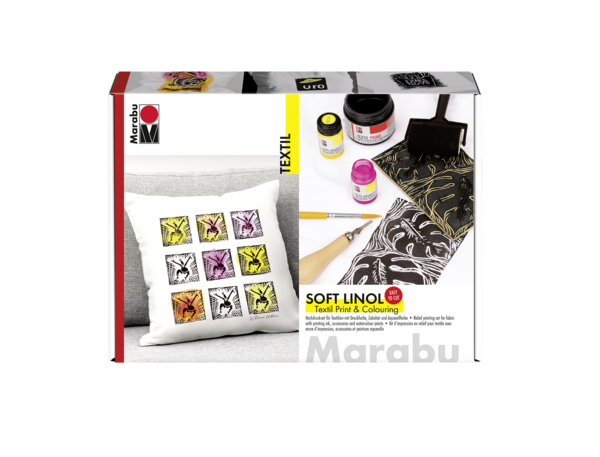
Marabu Textil Soft Linol Print & Colouring set

Marabu Brush-Set School & Textil

Marabu Decoration & Hobby, flat No.12

